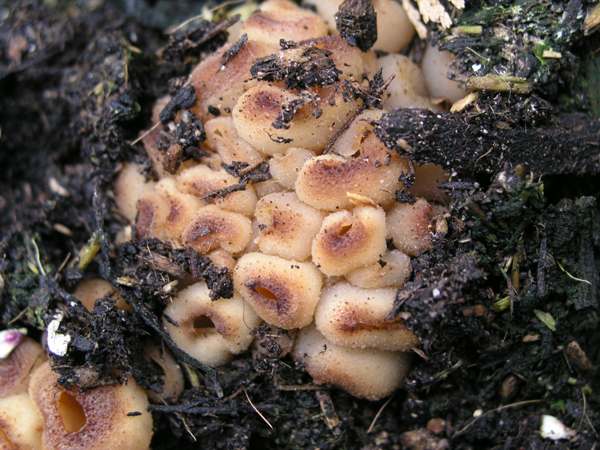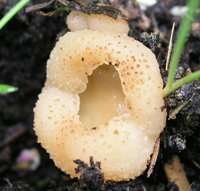Trees Birds Mammals Fish Amphibians Reptiles
Wild Algarve
Bookshop
Tarzetta catinus (Holmsk.) Korf & J.K. Rogers - Greater Toothed Cup
Phylum: Ascomycota - Class: Pezizomycetes - Order: Pezizales - Family: Pyrenomataceae
Distribution - Taxonomic History - Etymology - Identification - Culinary Notes - Reference Sources

This rather uncommon pezizoid fungus appears on rotten wood and on woodchip mulch. The neat, inedible little cups are often gregarious, jostling their neighbours for growing space and so developing irregularly. (Pictures: Robert Fisher)
Like so many of the cup fungi, identification is almost impossible without microscopic examination. Tarzetta catinus is difficult to separate from Tarzetta cupularis, which usually fruits in scattered groups rather than clustered.
Distribution
Uncommon but widespread across Britain and Ireland, Tarzetta catinus is found throughout mainland Europe and occasionally also in North America.
Taxonomic history
This ascomycete fungus was described in 1790 by Danish naturalist Theodor Holmskjold (1732 - 1794), who established its basionym when he gave it the binomial scientific name Peziza catinus. In 1971 American mycologists Richard P Korf and J K Rogers transferred this species to the genus Tarzetta, whereupon its scientific name became Tarzetta catinus.
Synonyms of Tarzetta catinus include Octospora pustulata Hedw., Peziza catinus Holmsk., Peziza pustulata (Hedw.) Pers., Pustularia catinus (Holmsk.) Fuckel, Aleuria albidaGillet, Peziza ochracea (Boud.) Sacc., and Pustularia ochracea Boud.
Etymology
Tarzetta, the generic name, is almost certainly a corruption of the Italian noun Tazzeta meaning 'little cup' - a reference to the diminutive size and general shape of fungi in this genus. (Tazza in Italian means cup, and probably comes from the French noun Tasse which has the same meaning.) The specific epithet catinus is derived from Latin and means a small bowl, basin or hollow.
Identification guide
 |
Fruitbody
The fruitbody comprises a fairly deep cup 1.5 to 5cm across often with only a rudimentary stem; inner surface is smooth, light ochre; outer surface is also light to mid ochre but downy; margin incurved and often darker brown towards the rim. |
| |
Asci
8-spored.
Spores
Ellipsoidal, smooth, 18.5-26 x 10-13µm; hyaline, with two large oil drops.
Spore print
With a slight yellowish tinge. |
Odour/taste |
Not distinctive. |
Habitat & Ecological role |
In broadleaf woodland, mostly under Beech trees; also on rotten wood and on woodchip mulch. |
Season |
June to November in Britain and Ireland. |
Similar species |
There are at least 100 Peziza species and most are various shades of fawn or brown. Definite identification is rarely possible without microscopic examination. |
Culinary notes
In common with the majority of the ascomycete cup fungi, this species is inedible.
Reference Sources
Fascinated by Fungi, 2nd Edition, Pat O'Reilly 2016, reprinted by Coch-y-bonddu Books in 2022.
Dictionary of the Fungi; Paul M. Kirk, Paul F. Cannon, David W. Minter and J. A. Stalpers; CABI, 2008
Dennis, R.W.G. (1981). British Ascomycetes; Lubrecht & Cramer; ISBN: 3768205525.
Breitenbach, J. & Kränzlin, F. (1984). Fungi of Switzerland. Volume 1: Ascomycetes. Verlag Mykologia: Luzern, Switzerland.
Medardi, G. (2006). Ascomiceti d'Italia. Centro Studi Micologici: Trento.
Taxonomic history and synonym information on these pages is drawn from many sources but in particular from the British Mycological Society's GB Checklist of Fungi.
Acknowledgements
This page includes pictures kindly contributed by Robert Fisher.
Top of page...
Fascinated by Fungi. Back by popular demand, Pat O'Reilly's best-selling 450-page hardback book is available now. The latest second edition was republished with a sparkling new cover design in September 2022 by Coch-y-Bonddu Books. Full details and copies are available from the publisher's online bookshop...